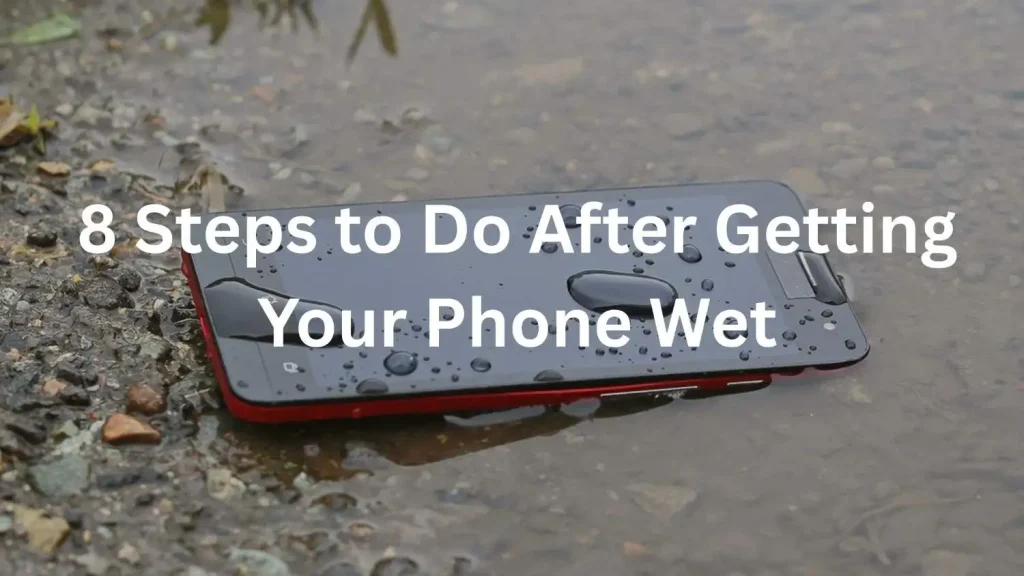Dropping your phone in water can be scary. It happens fast—one second you’re holding it, the next it’s in the sink, toilet, pool, or even the ocean. If this happens to you, don’t panic. You can often save a wet phone if you act quickly and follow the right steps.
In this guide, we’ll walk you through everything you need to know about what to do if your phone gets wet. From immediate actions to drying methods, and even what not to do, you’ll find simple and clear steps to give your phone the best chance of survival.
8 Steps to Do After Getting Your Phone Wet
Modern phones are built with some level of water resistance, but they are not completely waterproof. Water can damage circuits, cause corrosion, and make your phone unusable. The faster you act, the better chance you have of saving it.
Step 1: Take Your Phone Out of Water
This might sound obvious, but every second counts. The longer your phone stays in water, the deeper the liquid seeps into its ports and inside parts. Grab it quickly and move on to the next step.

Step 2: Turn It Off
Even if the phone looks fine, do not keep it on. Power it off right away. If you leave it on, the water can create a short circuit, which may cause permanent damage.

Step 3: Remove Accessories
Take off the phone case, screen protector, and unplug any headphones or charging cables. If possible, remove the SIM card, memory card, and battery. This helps air reach the wet areas and speeds up drying.

Step 4: Dry the Outside
Use a soft, lint-free cloth or paper towel to gently dab the phone dry. Don’t rub too hard—you don’t want to push water further inside. Gently shake the phone with the charging port facing down to let extra drops escape.

Step 5: Rinse if Needed
Did your phone fall in salt water, pool water, or soapy water? If yes, give it a quick rinse with clean tap water. Why? Because salt and chemicals are more harmful than fresh water. Just remember—you must dry it properly afterward.

Step 6: Use the Right Drying Method
You may have heard about putting your phone in rice. This is not the best idea. Rice doesn’t absorb deep moisture well, and it can leave dust and starch inside your phone.
Instead, use silica gel packets (those small bags that come with shoes, electronics, or bags). Place your phone in a sealed container or zip-top bag with several silica gel packets. Leave it for at least 24–48 hours. Silica gel absorbs moisture more effectively and safely.
If you don’t have silica gel, leave your phone in a cool, dry, well-ventilated place for the same amount of time. Patience is important—don’t rush this step.

Step 7: What Not to Do
Many people make mistakes that make the damage worse. Avoid these common errors:
- Do not use a hairdryer. The heat can damage internal par
- Do not put your phone in the microwave or oven.
- Do not try to charge it while wet. Electricity and water don’t mix.
- Do not turn it back on too soon. Wait until you are sure it’s fully dry.
Step 8: Test the Phone
After 24–48 hours, take your phone out of the drying bag and try turning it on. If it powers up, that’s a good sign. Charge it fully and test all features—camera, sound, charging port, and touchscreen.
Keep an eye on the phone for the next week. Sometimes problems show up later, like screen flickering, muffled speakers, or overheating.

Place the phone in silica gel packets
Forget the rice myth. Silica gel is a proven moisture absorber. Put your phone in a sealed bag with silica gel for 24–48 hours.

When to Get Professional Help?
If your phone doesn’t turn on after drying, or if it still has problems, it’s time to visit a professional repair shop. Experts have tools to clean corrosion, dry internal parts, and replace damaged components.
Don’t wait too long—water damage can get worse over time. A fast repair could save your phone and your data.
How to Prevent Future Water Damage?
Of course, the best cure is prevention. Here are some tips:
- Use a waterproof phone pouch if you’re going near water.
- Avoid using your phone in the bathroom or kitchen sink area.
- Don’t leave it on the edge of the pool or bathtub.
- Invest in a phone with a high water-resistance rating (look for IP67 or IP68).
















